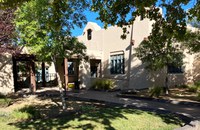Special Collections Library Listed on National Register of Historic Places
The Public Library of Albuquerque/BernCo is pleased to announce that the Special Collections Library has been officially listed on the National Register of Historic Places as of August 9, 2024. This recognition highlights the building’s significant contribution to the cultural and architectural heritage of Albuquerque.
“We’re happy this beautiful historic building in Albuquerque has been officially recognized by being placed on the National Historic Register,” said Acting Library Director Kelli Murphy. “Library staff offer tours each month, so we invite community members to visit and enjoy this unique space.”
“In Albuquerque, we celebrate our unique heritage and culture, and the Special Collections Library is an important place that keeps our history alive,” said Mayor Tim Keller. “We protect our historic places so they will continue to be valuable resources for families to connect and learn about our shared past.”
The Special Collections Library, located at 423 Central NE, is a vital part of Albuquerque’s history and community. In March 2025, the library will celebrate its 100th anniversary, further underscoring its importance as both a historic site and a hub for local research and preservation.
As a resource for those interested in Albuquerque’s past, the library offers public tours each month, providing visitors with insight into the building’s architectural beauty and its special collection of local history materials. The library is committed to preserving this important landmark for future generations and invites the community to celebrate with them as they approach their centennial.
The Special Collections Library is home to a wide variety of materials dedicated to Albuquerque's history and culture. Its collections include historical photographs, maps, genealogical records, and a vast array of rare books. The building itself is a significant example of Pueblo-Revival architecture, beloved by residents and historians alike.

